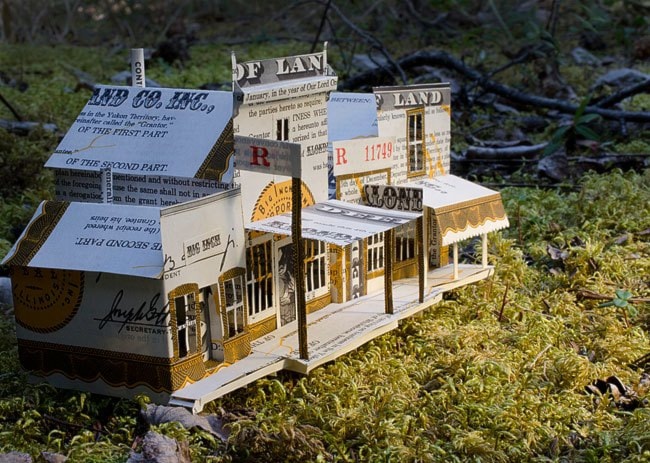Sixty years ago almost 21 million deeds went out into the world promising wannabe land barons their own piece of the Klondike.
A very, very tiny piece.
Starting in 1955, each box of Quaker Puffed Rice and Puffed Wheat cereal contained a document purporting to entitle the owner to one square inch of the Yukon Klondike.
About half-a-page in size, with a gold border, an official-looking seal, individual tract number, and full of legal jargon, the deeds were enough to capture the imagination of any young person eating their morning cereal.
It looks important enough to want to keep safe, and many people did just that, for a very long time.
What started out as a gimmick to get kids to ask for Quaker cereal still has life decades later.
There are still queries being made to Yukon government offices asking about the tracts of land. The promo has since been called one of the biggest cereal marketing campaigns in history.
Most recently, some of the deeds have been turned into an art exhibit that opened last week in Dawson.
* * *
In 1955, the Quaker cereal company bought 19.11 acres of Yukon land about 12 miles north of Dawson City along the Yukon River. That’s pretty close to where the golf course sits today.
It cost the company about $1,000 and they raised title in the name of the Klondike Big Inch Company.
The land was divided up inch by inch and the mock deeds slipped into cereal boxes.
The promotion was a tie-in to Quaker’s sponsored television show Sergeant Preston of the Yukon, and meant to capitalize on society’s fascination with the North.
By 1965 the cereal had been eaten, the promotion was done.
The Klondike Big Inch Company dissolved like a rice puff left at the bottom of a bowl of milk.
Eventually the Yukon government took back the land for non-payment of taxes. Quaker owed $37.20.
* * *
Sixty years later, the Yukon’s lands titles office still gets the odd call or letter about the deeds found in the bottom of someone’s drawer or while cleaning out a relative’s house.
Registrar Denise Dollin says there are five stacks of file folders in the office dating back to the 1960s full of letters from people inquiring about their piece of the Klondike.
There’s one from someone offering to donate three square inches of land to a national park.
There’s one from a concerned citizen worried that they haven’t heard from the taxman and wondering how much they owe in back taxes.
“We’ve received string and four toothpicks and somebody wanted us to go out and stake their track of land for them,” she said.
The Yukon office has a form letter that they’ll send back to anyone who inquires explaining that it was all a gimmick to sell cereal.
Not everyone is surprised when they find out it’s a gag, she said. There’s at least one red flag. Each deed has a spot where the owner is supposed to fill in his or her name.
Sometimes the name is scribbled in pencil.
* * *
Vancouver artist Kevin Murphy says it doesn’t matter that the fine print makes it clear the deeds aren’t real. The promotion was all about using kids’ imaginations and building on the fantasy of the Yukon.
As part of his artist in residence program at Dawson’s Klondike Institute of Art and Culture, Murphy found a new use for the deeds.
“Like all things that have no intrinsic worth, they become collectibles and they go to the land of eBay,” he said.
Some of the deeds he snapped up look brand new, while others have names scrawled across the front.
He cut up the deeds and made sculptures of “the kinds of things that I imagine these kids might have been imagining” when they pulled the papers out of their cereal.
He made models of mine shafts, cabins and storefronts, wall tents and prospectors’ camps.
After figuring out the formula Quaker used to divide up the land, Murphy brought the deeds home to their corresponding inch.
Some of the models ended up in the woods, similar to how things would have looked when Quaker first bought the land.
One is in a tire rut in the middle of the road and another ended up in a horse corral.
Nine photos of the models on the land they represent make up Murphy’s show, One Inch More Or Less, which is on display at Dawson’s ODD Gallery until Sept. 18.
The show is part of The Natural & The Manufactured, a project jointly organized by the gallery and the artist in residence program.
Quaker never intended for people to own the land, Murphy said. It was real but never really meant to exist anywhere except in people’s imaginations.
He said his work looks at the complicated relationship between a physical place and the human baggage or lenses that we see it through.
“It was this imaginary place. They bought the land but they didn’t necessarily have any sort of tie to that land. It was more (that) they were selling the idea of the North, and it was all coded in these sort of romantic associations.”
Contact Ashley Joannou at
ashleyj@yukon-news.com
